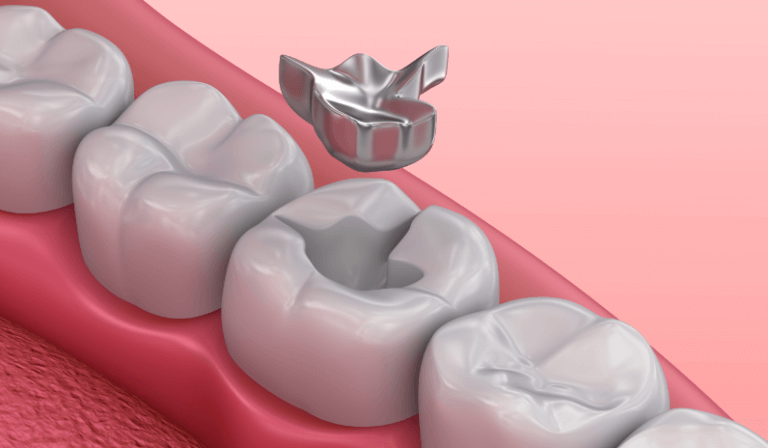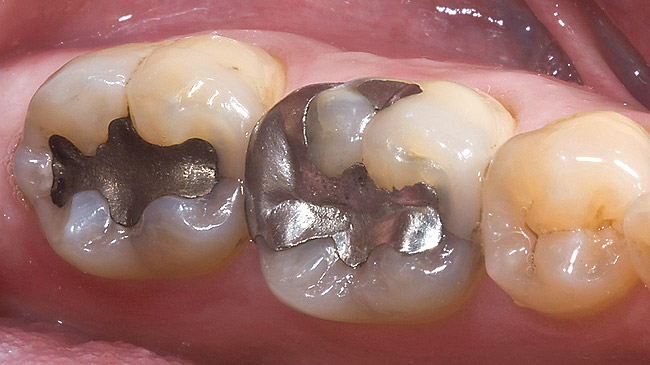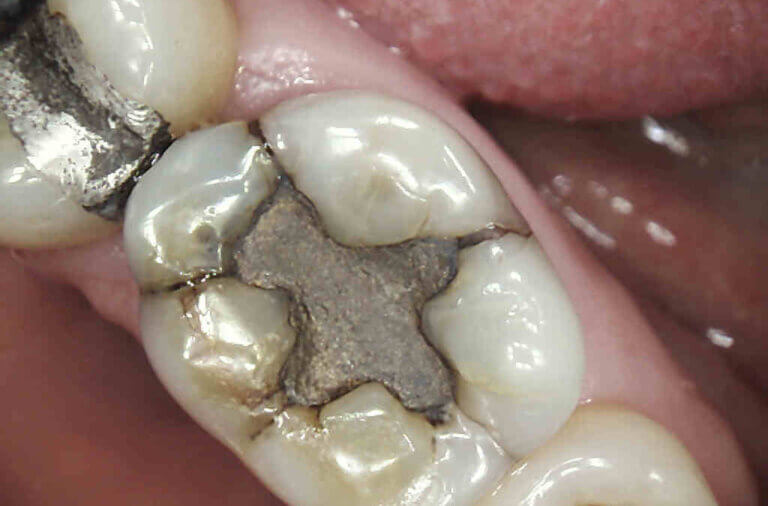Amalgam Filling

What Is An Amalgam Filling?
An Amalgam Filling is a durable dental filling material used to restore teeth compromised by dental caries (cavities). It is made from a mixture of metals, including silver, tin, copper, and mercury. Despite being called a “silver filling,” its appearance is more of a silvery-gray, making it noticeable in front teeth. However, it excels in restoring molars and premolars, where strength matters most, and visibility is less important. Amalgam fillings have been a trusted solution for over a century, known for their affordability and effectiveness in treating cavities.
Before deciding if amalgam fillings are right for you, it’s important to know:
- Who Needs An Amalgam Filling?
- Benefits Of An Amalgam Filling
- Risks Of An Amalgam Filling
- Alternative Treatments To Amalgam Filling
- How Much Does An Amalgam Filling Cost?
- Steps In The Amalgam Filling Procedure
- Frequently Asked Questions About Amalgam Fillings
If you have any further questions about an Amalgam Filling or other dental services offered at Atlas Dental, please contact us.

Free phone consultation
Have questions about tooth fillings? Schedule a free phone consultation with our Toronto dentist.

5 star google reviews
Our patients love us! See for yourself why more and more people are choosing Atlas Dental for their dental fillings.

Book Emergency tooth filling
Do you think you have cavities and need an appointment? Book an emergency tooth filling online.
Who Needs An Amalgam Filling?
Amalgam fillings are ideal for various dental situations, including:
- Large Cavities: When cavities are substantial, amalgam offers strong, long-lasting restoration.
- Durability: They withstand the chewing forces on molars and premolars, where pressure is highest.
- Cost-Effectiveness: Amalgam is more affordable than many other restorative materials.
- Quick Application: The placement procedure is fast, making it convenient for those with time constraints.
- Preference for Metal Fillings: Some patients prefer the traditional feel and strength of metal fillings.
There are concerns about mercury in amalgam fillings, but regulatory bodies like the ADA and CDA consider them safe. If you have further questions about Amalgam Fillings, please contact us.

Benefits Of An Amalgam Filling
Here’s why amalgam fillings remain a popular choice:
- Durability: They last over a decade with proper care.
- Strength: Ideal for molars and premolars, they endure heavy chewing forces.
- Affordability: More cost-effective than composite resin or porcelain alternatives.
- Quick Placement: The procedure is fast and straightforward.
- Versatility: Suitable for both small and large cavities.
- Reduced Sensitivity: Patients often experience less post-operative sensitivity compared to other materials.
- Proven Track Record: Amalgam fillings have been used safely for over 100 years.
Despite these benefits, many people prefer tooth-colored fillings for visible areas like the front teeth. If you have concerns about mercury, speak with your dentist about alternatives. If you have further questions about Amalgam Fillings, please contact us.
Risks of An Amalgam Filling
While amalgam fillings have been used for decades due to their durability and affordability, they do come with potential risks that patients should consider:
- Mercury Exposure: Amalgam fillings contain approximately 50% mercury, a heavy metal that releases small amounts of vapor over time. Chronic exposure to mercury has been linked to potential neurological and kidney-related effects, though research is still inconclusive on its impact from dental fillings.
- Allergic Reactions: A small percentage of patients may be allergic to the metals in amalgam, such as mercury, silver, or tin. This can cause localized irritation, swelling, or rash.
- Tooth Fractures: Amalgam expands and contracts with temperature changes, which can lead to cracks in the surrounding tooth structure over time. These cracks may require further dental treatment, such as crowns or even root canals.
- Aesthetic Concerns: The silver-grey color of amalgam fillings makes them more noticeable, especially on front or visible teeth. Many patients prefer tooth-colored composite fillings for a more natural look.
- Environmental Concerns: Mercury from amalgam fillings can enter the environment through dental office waste, prompting regulations on safe disposal. Some organizations advocate for reduced use of amalgam to minimize environmental impact.
Patients considering amalgam fillings should discuss these risks with their dentist and explore alternative filling materials, such as composite resin or ceramic, for a safer and more aesthetic option. If you have further questions about Amalgam Fillings, please contact us.

Alternative Treatments To Amalgam Fillings
If you prefer not to choose amalgam, other options include:
- Composite Resin Fillings: Also known as tooth-colored fillings, they blend with your natural teeth and require less removal of healthy tooth structure.
- Glass Ionomer Fillings: These release fluoride to help protect against decay but are less durable than amalgam.
- Porcelain Inlays and Porcelain Onlays: Custom-made, durable, and natural-looking, porcelain restorations are ideal for larger cavities.
- Dental Crowns: For severely damaged teeth, crowns cover the entire tooth for protection.
- Dental Veneers: Thin shells applied to the front of the teeth, mainly for cosmetic improvement.
Your dentist will guide you on the best option for your situation based on your needs, preferences, and budget. If you have further questions about Amalgam Fillings, please contact us.
Cost of Amalgam Fillings
Routine Dental Fillings cost $207-477 depending on the location of the tooth (anterior, bicuspid or molar), as well as the number of “surfaces” involved. Imagine each tooth as a 5 surface box. Each “surface” of this imaginary box will dictate the size (and cost) of the tooth filling. The codes relevant to regular dental fillings in the Ontario Dental Association’s Suggested Fee Guide appear as follows:
Permanent Anteriors:
- 23111 – One surface: $205
- 23112 – Two surfaces: $256
- 23113 – Three surfaces: $308
- 23114 – Four surfaces: $379
- 23115 – Five surfaces (maximum surfaces per tooth): $400
Permanent Bicuspids:
- 23311 – One surface: $226
- 23312 – Two surfaces: $283
- 23313 – Three surfaces: $339
- 23314 – Four surfaces: $414
- 23315 – Five surfaces or maximum surfaces per tooth: $435
Permanent Molars:
- 23321 – One surface: $246
- 23322 – Two surfaces: $308
- 23323 – Three surfaces: $369
- 23324 – Four surfaces: $451
- 23325 – Five surfaces or maximum surfaces per tooth: $477
Regular Dental Fillings are considered a basic service under all dental insurance plans and should be covered to your maximum insurable limit, but be sure to find out from your dental insurance plan provider how much you are eligible for before going ahead with dental treatment. Our fees are consistent with the ODA Fee Guide.
For patients without dental insurance, Atlas Dental is pleased to offer dental financing through iFinance Dentalcard. Affordable payment plans start at 7.95% for terms of 6 months to 6 years. To learn more about Dentalcard dental treatment financing, follow this link.
Steps In The Amalgam Filling Procedure
Here’s what to expect during an amalgam filling procedure:
- Examination: Your dentist examines the tooth and may take X-rays to assess the cavity.
- Anesthesia: Local anesthetic is applied to numb the area.
- Tooth Preparation: The decayed portion of the tooth is removed.
- Amalgam Placement: The amalgam mixture is carefully placed into the cavity and shaped.
- Bite Check: The dentist ensures your bite is even.
- Polishing: The filling is polished for smoothness and to prevent plaque buildup.
The amalgam filling procedure is generally straightforward and can be completed in one dental visit, making it a convenient option for restoring damaged teeth. If you have further questions about Amalgam Fillings, please contact us.

Frequently Asked Questions About Amalgam Fillings
- Are amalgam fillings safe?
Amalgam fillings contain about 50% mercury, which releases toxic vapor that can be absorbed by the body. The International Academy of Oral Medicine and Toxicology (IAOMT) and other experts warn that mercury exposure may pose risks to neurological, immune, and kidney health. For patients concerned about mercury toxicity, safer alternatives like composite resin, ceramic, or gold fillings are available.
- How long do amalgam fillings last?
Amalgam fillings are highly durable and can last 10-15 years or longer with proper care. Their longevity makes them a reliable option for restoring cavities, especially in molars that endure heavy chewing forces.
- Can amalgam fillings be replaced with tooth-coloured fillings?
Yes, amalgam fillings can be replaced with tooth-coloured materials like composite resin for aesthetic reasons or if the filling is damaged. However, your dentist will evaluate if replacement is necessary based on your dental health.
- Do amalgam fillings require special care?
Please read our Dental Filling Post-Operative Instructions. Brush twice daily, floss regularly, and visit your dentist for routine check-ups to ensure your amalgam fillings and overall oral health remain in good condition.
By taking proactive steps to care for your oral health and scheduling regular dental check-ups, you can maximize the lifespan of your amalgam filling and enjoy the benefits of a healthy, functional smile for years to come. If you have further questions about Amalgam Fillings, please contact us.

